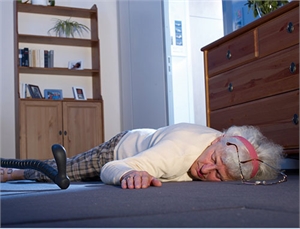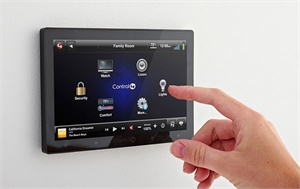Caring for Older People
Home automation can help older people stay in their own home, or in an assisted living accommodation longer, and so delaying the less acceptable choice of taking up residence in a care home. Unfortunately, the lack of reliability and the complexity of existing home automation systems render them unsuitable for use by older people, and by those most interested in their welfare.
A Perfect Storm
The ageing population in the UK, and probably in other countries, is heading towards a perfect storm. This due to a combination of the increasingly higher proportion of older people in the population as a whole, rising care home costs, under resourced social care, falling incomes, and lower tax revenues.

There are nearly 12 million people between 66 and 85, and a further 1.5 million are over 85. These figures are forecast to rise to 17.5 million and 3 million respectively over the next 20 years. A significant proportion also live on their own, and have dementia, or some other debilitating illness.
There are 7 million unpaid carers in the UK, of which 350,000 are young adults. They save the state £130 billion per year, which is a similar amount to entire NHS budget for the UK.
Helping older people to stay in their own home, or in an assisted living accommodation, prolongs their independence, and their lives, as well as minimizing the cost of their care. This must be achieved without detriment to their health, well-being, security, or comfort.
Statistically, moving into a care home reduces a person’s life expectancy by up to 2 years, whereas remaining in a home of their own increases their life expectancy by up to 5 years.
Home automation can also provide assistance for unpaid carers, which will encourage the retention of this very valuable resource.
The Home Companion
The following table gives an indication of some of the main ways in which a home automation system can benefit the older person in their home.
Schedule heating throughout each day of the week. Boost heating.
Schedule lights to switch on and off.
Enable door sensors & motion sensors. Daytime / Evening / Overnight.
Monitor behaviour patterns with motion sensors. Temperature sensors to detect hypothermia & heat stroke. Automatic alerting.
Panic buttons. Smoke detectors.
The following table gives an indication of some of the main ways in which better communications with the outside world can benefit the older person in their home.
Chat, problems, queries, emergencies, etc.
Avoid promotions & other distractions.
Local, UK & world. Facts & not opinions.
Conference with helper & GP.
While most of these technologies are well-established, they need to be tailored to the needs of the older person, as viewed from the perspective of older people, and taking account of their likely infirmities.
System Reliability
As evidenced by the many complaints about the operation of some home automation systems in forums, Facebook pages, and other social media, their low poor reliability is barely acceptable to normal users. Rather than being an aid for older people, they are more likely to be an annoyance and a liability.
If someone is relying on a remote connection to monitor the health and wellbeing of an older person, then that connection must be reliable. If the connection fails, its what's known dormant failure, because the older person could be in harms way, but the message would not reach the remote user.
Equally, if the remote user is relying on data being reported by devices with the older person's home, then those devices must be reliable, as must the communication between the device and the hub. If not, then again the older person could in harms way without the remote user being aware.
The opposite also applies. If a device repeatedly fails, and the hubs sends a false alarm to the remote user, then they will have to spend time checking out a non-existent issue. This in turn will cause the remote user to lose confidence in the system.
As described elsewhere, we have placed a much higher level of importance than others on the system health, its security, and the protection of the person's privacy. While this takes us a long way down the right road for its use by and for older people, there is still further to go.
Other home automation systems that place much less importance on these aspects have a much higher mountain to climb.
Ease of Use
The main target market for home automation systems is amongst the younger population, and little, if any, consideration is given to their use by older people.
While the same technology can be employed for use by an older person, it must be tailored to their specific needs. To this end, only those facilities that are necessary and sufficient are included, and these are made as easy as possible to use.
Merely complying with accessibility requirements, such as those specified by W3C, falls well short of the needs of the older person.

The user interfaces into the system, both for controlling the home automation, and for communicating with the outside world, must instead be tailored specifically to needs of the older person. This calls for greater use of larger screen devices, and especially tablet devices, with much greater real emphasis placed on simplicity and ease of use.
The older person has also to be shielded from the underlying technology, including its setup, and dealing with any issues that might arise during its use.
This requires the inclusion of software running on the hub to provide self-monitoring and self-healing of the system wherever possible. It also requires that other authorized people can access the system remotely to manage it on behalf of the older person.
Helpers & Carers
Technology alone is not enough. Older people also need the support of a helper. This person does not need any special skills, beyond those required for their normal daily life. Their role is to deal with any everyday issue that might limit the older person’s ability to remain in their own home.
These helpers provide this service remotely via the Internet, so they do not even need to leave their own home. They can both communicate with the older person, via their tablet based control panel, and manage their home automation system.
Helpers will be on standby most of the time, in anticipation of an older person needing assistance, so each helper can support several older people. There can also be a network of helpers, so that their responsibilities can be shared.
A helper might be a family member or a close friend. In an assisted living home setting, the helper is more likely to be someone already in that role within the community.
This same technology can also be beneficial to carers, because it will enable them to continue to care for an older person remotely. This gives the carer more freedom to pursue their own interests, while still being able to provide the necessary support to the person for whom they are caring.